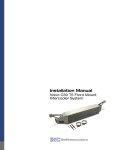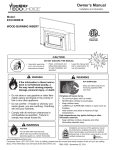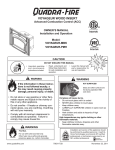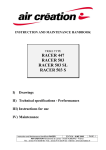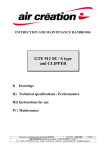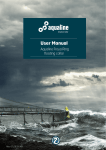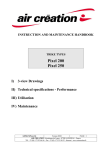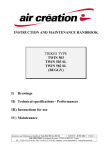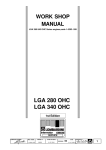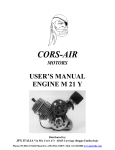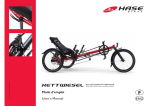Download Mountain Bike Technical Article
Transcript
Technical Brief No.: TB-09-0528 Title: Mountain Bike Maintenance Part 1 of 2 For many New England mountain bikers and other cyclist, spring is that time of the year to make sure your bike is safe and ready to ride. Whether you ride year round, once to the corner store or pack up the bike for the winter months, it is always best practice to perform annual maintenance ensuring no potential mechanical failures are evident. If you are an individual who brings his or her bicycle to the local bike shop for service, you may be onestep ahead rather then doing it yourself. However, every mountain biker should be familiar with the bike they ride since a pestering mechanical problem could rear its ugly head leaving you no time to bring it to your local bike shop. This article will identify and explain some basic maintenance points a do-it-yourself mountain biker can perform on your mountain bike at home with minimal tools. Technical Brief Section: Below are the following section covered in this article (Part 1 of 2). Each section provides a basic level of information relative to the topic. This document does not cover all technical, engineering and or maintenance aspects of mountain bicycle maintenance or repair. 1.0 Basic Approach & Essential Tools. 2.0 The Starting Point. 3.0 Frame. What to look for. 3.1 Frame Welds. 3.2 Frame Ovalizing. 3.3 Mechanical Interference. 3.4 Frame Tubing. 4.0 Drive-train & Shifters. 4.1 Chain. 4.2 Front Sprocket(s). 4.3 Front Derailleur. 4.4 Rear Cassette. 4.5 Rear Derailleur. 4.6 Rear Derailleur Hanger. 4.7 Shifters. 5.0 Suspension. 5.1 Check for fluid leaks. 5.2 Check the Stanchions. 5.3 Check the Air Pressure. 5.4 Check the Coil Spring. 5.5 Check the Spring Retainer Plate. 5.6 Grease those Bearings & Bushings. 6.0 Technical Wrap-up. Document Disclaimer: This technical brief provides reference only information for bicycle components and or maintenance techniques. This document does not constitute a publication or a standard to repair, maintenance, assembly and or fabricate a mechanical device classified as a bicycle nor to be used as such for other mechanical devices not classified as a bicycle. Contents in this document can not be reprinted or published without written consent of Dieselbikes. Pg. 1 of 8 DIESELBIKES P.O. Box 724 • Lynnfield, MA 01940 • www.dieselbikes.com 1.0 Basic Approach & Essential Tools. There are two basic approaches for the do-it-yourself biker when performing maintenance on your mountain bike. The first approach is to strip all the components off your bike’s frame excluding the headset cups. The more basic approach is to remove what components you can with the tools you have and inspect/clean everything else that is still mounted on the frame. It will be much easier to perform maintenance if everything is removed from the frame, but both approaches will allow you to become familiar with the mechanics of your mountain bike. If you consider your hands to be all thumbs, having the right tools will make the job much easier and less damaging to your components. I have personally seen pipe wrench marks on wheel hub cones because the individual did not have the correct size cone wrench to tighten them. Fortunately many mountain bikes share similar sized mounting hardware and mechanical connections (i.e. crank arms) have been narrowed down to a hand full of standard configurations. Regardless of standardization, your mountain bike may require a specific tool that your local bike shop may not have. So it would be a good idea for you to familiarize yourself with your bike and identify what tools are required to properly perform service. Below is a list of tools broken down into categories a do-it-yourself biker should have before you attempt to service your bike. Please note this tool list does not cover everything you need for bicycle repair; just the basics to perform bicycle maintenance. Basic Essential Tools The next step up Metric Allen Wrench Set 1.5mm ~ 10mm Metal bicycle tire levers Small Adjustable Wrench Chain Tool Bicycle pump Flat Screwdriver Phillips Screwdriver Basic essential tools PLUS Bike repair stand Pedal Wrench Spoke Wrench Chain Whip Cassette Lockring Tool Cable Cutter Almost everything you need. The next step up PLUS Bottom Bracket Tool Crank Puller 6” Vise Cone Wrench(s) Star Wrench Set size T7, T9, T10, T15, T20, T25, T27, T 30 Torque Wrench Document Disclaimer: This technical brief provides reference only information for bicycle components and or maintenance techniques. This document does not constitute a publication or a standard to repair, maintenance, assembly and or fabricate a mechanical device classified as a bicycle nor to be used as such for other mechanical devices not classified as a bicycle. Contents in this document can not be reprinted or published without written consent of Dieselbikes. Technical Brief #: TB-09-0528 DIESELBIKES Pg. 2 of 8 P.O. Box 724 • Lynnfield, MA 01940 • www.dieselbikes.com 2.0 The Starting Point. One of the biggest questions to answer before you start is: “where do I start?” We consider every component on your mountain bike important and where you start your maintenance should not be a gated question. However, since all your components attach to your bike frame, it would be best practice to check your frame first. You do not want to spend hours checking all the other components just to find out your bike frame has a stress crack. After checking the frame, the order in which you approach everything else is up to you. We at Dieselbikes personally following one of these two methods: a. Leaving the bike assembled, we check the frame first and then start with the handlebars working back towards the rear wheel (top-down method). b. Removing all the components from the frame, we check the frame first and then deal with the components that we know are giving us problems (tear-down method). Each method will pose different challenges for inspecting and cleaning techniques, but in the end you will know more about your bike and have the confidence to tackle your next maintenance cycle. 3.0 Frame. Some riders can literally feel frame flex when they ride and know when their frame has a stress crack or is approaching the end of its usability. For the rest of us, checking the frame can be a daunting challenge and is an important step many of us skip. The simplest technique to check your frame, regardless you remove the components, is to carefully look it over in a well lighted area. If a well lighted area is not available, the use of a flashlight can help spot potential problems you may miss if view the frame in poor light. What to Look For Once you have wiped your frame clean (or as clean as you can get it) of foreign material, you want to begin your inspection by looking these points listed below: 3.1 Frame Welds. Frame welds are designed to be the strongest points on the bike; however, they are also junction points that take enormous loads when you ride. Look for paint cracks or flaking in areas along the welds. This could be an indicator there may be an underline stress fracture in the weld. However, you should also understand that paint cracks or flaking can result from damage occurred during trail riding. If you do find paint missing on the welds, carefully look for a crack in the bear metal. If you cannot find anything but are still concerned, mark the area with a sharper or white out and check it again after a few rides to ensure more paint is not flaking. Document Disclaimer: This technical brief provides reference only information for bicycle components and or maintenance techniques. This document does not constitute a publication or a standard to repair, maintenance, assembly and or fabricate a mechanical device classified as a bicycle nor to be used as such for other mechanical devices not classified as a bicycle. Contents in this document can not be reprinted or published without written consent of Dieselbikes. Technical Brief #: TB-09-0528 DIESELBIKES Pg. 3 of 8 P.O. Box 724 • Lynnfield, MA 01940 • www.dieselbikes.com 3.2 Frame Ovalizing. Look for ovalizing of the head tube and bottom bracket. On a bicycle frame, the basic term for ovalizing is when a circular tube/shell is forced into an oval shape. When this condition occurs to the head tube or bottom bracket, the material that once was circular has now stretched into an oval pattern weakening its structural integrity. 9 out of 10 times this condition will first occur on the bottom of the head tube in line with the frame. Missing paint where the headset contacts the frame and or binding of your handle bars as you turn them back and forth could be an indication of ovalization. The bottom bracket shell will be harder to check visually since it’s the lowest point of the frame in relation to the trail and takes a beaten when you ride. A good method to check the bracket shell is to remove the bottom bracket; insure the shell threads on the frame and bracket cups are clean and then install just the cups by hand with a light lubricate. Once the bracket cups are threaded more then half way into the frame, they should begin to become snug and not to have any side-to-side play or looseness in the direction of the thread. If you thread the cups into the frame and they are loose, you may have a problem with the frame shell or bottom bracket cups. We would suggest taking your bike to a well qualified bicycle mechanic who can measure the bracket shell and bracket cups to ensure they are within manufacturers specifications. 3.3 Mechanical Interference. Check the frame for mechanical interference. Many of us buy a new bike, ride it for 6 months and then check it only to find the brake line was cutting in to the frame just because it was rubbing. Mechanical interference can lead to premature frame failure if unchecked. We have personally seen frames where the side wall of the down tube was damaged beyond repair due to the rear brake cable rubbing the frame. We suggest you carefully look for frame wear that can or has resulted from mechanical interference and resolve the problem immediately. Document Disclaimer: This technical brief provides reference only information for bicycle components and or maintenance techniques. This document does not constitute a publication or a standard to repair, maintenance, assembly and or fabricate a mechanical device classified as a bicycle nor to be used as such for other mechanical devices not classified as a bicycle. Contents in this document can not be reprinted or published without written consent of Dieselbikes. Technical Brief #: TB-09-0528 DIESELBIKES Pg. 4 of 8 P.O. Box 724 • Lynnfield, MA 01940 • www.dieselbikes.com 3.4 Frame Tubing. Lastly you want to check the frame tubing for stress or hairline cracks. Most mountain bike frames will be littered with dents and scratches from our abusive trail riding. You should check these locations for metal fatigue to insure no scratches are migrating (growing). If you have a deep cut or scar in the frame that concerns you, we suggest painting or dabbing both ends with liquid white out before your next ride. Once you finished your ride, check the liquid white out for cracks or flaking this may be a sign your frame is damaged. We have had good results using liquid white out to detect frame cracks, even on a white or non-painted frame. 4.0 Drive-train & Shifters. Your bicycle drive-train is the heart and sole of your riding experience, yet when it comes to maintenance, it usually is the most neglected. Your drive-train has the most moving parts in one assembly; it utilizes a derailleur to shift gears that also applies tension to minimize chain slack and is required to operate fully exposed to the outside elements. During any maintenance period, it is best practice to check your drive-train for smooth operation, clean off any heavy debris and apply lubrication as required. Symptomatic problems such as chain slippage, gear skipping and chain suck can be greatly reduced by performing periodic maintenance. Below are some maintenance checkpoints for your mountain bike drive-train. 4.1 Chain. The chain is probably the most important component in the drive-train. You want to frequently clean and inspect the chain to ensure it is in good working order. We suggest reading our Technical Brief # TB-09-0124 regarding bicycle chain maintenance. 4.2 Front Sprocket(s). Whether you have one, two or three front sprockets, the need to clean and remove debris is the same. Cleaning the front sprocket(s) while it’s still assembled on the crank arm is fairly easy, but occasionally you should remove the sprocket(s) from the crank arm for a complete cleaning and inspection. Many times cleaning the front sprocket(s) still attached to the crank arm will not allow you to remove heavy built-up grime. This grime will not only transfer back onto other components of the drive-train, but also accelerate wear. You should also check for excessive wear of the sprocket(s). There is no specific science for checking sprocket wear, most aggressive mountain bikers destroy their bike before wearing out a single sprocket. There are different techniques to check for wear and for the average mountain bike it would be best to consult a well qualified bicycle mechanic for assistance. 4.3 Front Derailleur. The front derailleur is the easier of the two derailleurs on your mountain bike to maintain; if you even have a front derailleur. Many mountain bike front derailleurs can be cleaned fairly well still mounted on the frame. For the average mountain biker, you probably choose to clean the derailleur still mounted on the frame to save the hassle of de-tensioning the shifting cable and re-adjusting once you remount the derailleur to the frame. Document Disclaimer: This technical brief provides reference only information for bicycle components and or maintenance techniques. This document does not constitute a publication or a standard to repair, maintenance, assembly and or fabricate a mechanical device classified as a bicycle nor to be used as such for other mechanical devices not classified as a bicycle. Contents in this document can not be reprinted or published without written consent of Dieselbikes. Technical Brief #: TB-09-0528 DIESELBIKES Pg. 5 of 8 P.O. Box 724 • Lynnfield, MA 01940 • www.dieselbikes.com This may be one of those components you can cheat on when maintaining your mountain bike, but you should still familiarized yourself with appropriate installation and adjustment methods (consult product mfg’s manual) so you can remove the derailleur for proper cleaning and inspection. 4.4 Rear Cassette. Rear cassettes are an art form these days. 8-speed or 9speed mountain bike cassettes are designed to efficiently engage the chain under various loads and rotational speeds to ensure your power is put to the wheel. This explains why they are costly to replace. Just like front sprockets, frequent cleaning and inspection will maintain the products designed performance and increase its usable cycle life. Unlike the front sprockets, cleaning the rear cassette still attached to the hub is not the best practice. Even if you removed the wheel from your bike and attempt to clean the cassette with an old tooth brush, you are still going to waste more time and energy then just removing it. You also run the risk of contaminating your hub with dirty cleaning solution as you try to clean the cassette. We truly suggest investing in a cassette removal tool for maintaining this drive-train component. In the end you will be able to clean the cassette more frequently in much less time then leaving it mounted on the hub. Again, there is no specific science for checking cassette wear but there are a number of techniques. We would suggest you consult a well qualified bicycle mechanic for assistance on identifying cassette sprocket wear. 4.5 Rear Derailleur. Your rear derailleur can be one of the trickiest drive-train components to maintain. Hanging below the chain stay, the rear derailleur is exposed to debris kicked up by your wheels and near misses as you pass around trail obstacles. When performing maintenance on your rear derailleur, the first item you want to check is the straightness of the derailleur cage. The cage is the derailleur component that contains both pulleys. If this cage is bent or misaligned you will feel plenty of frustration shifting your gears when riding. There are methods to fix a misaligned cage, but for the average mountain bikers, you may want to replace it. Don’t be afraid to clean your derailleur pulleys. The derailleur pulleys (or tension pulleys) are ideal locations for grime buildup that affect the overall performance of your drive-train. The pulleys should be removed periodically to be cleaned and lubricated. Also, check and lubricate the pivot point on the derailleur body to ensure smooth operation when shifting gears. Derailleur alignment is critical for excellent performance. Most mountain bikers will not have access to an alignment tool, so you will need to rely on visual inspection. We suggest reading our Technical Article # TA-09-0430 regarding bicycle Derailleur maintenance. 4.6 Rear Derailleur Hanger. Check this component at the same time you check the rear derailleur. The rear hanger can be the culprit a number of drive-train issues if the hanger is misaligned. There are tools available to measure and straighten a bent hanger; however, for the average mountain biker; your eyes may be your best tool. If your hanger is slightly bent, remove it from the bike and use a vice or two adjustable wrenches to straighten. Be careful because every time your hanger bends, it weakens and will break. We suggest carrying an extra hanger (as back-up) when you ride in the event you need to replace it. Document Disclaimer: This technical brief provides reference only information for bicycle components and or maintenance techniques. This document does not constitute a publication or a standard to repair, maintenance, assembly and or fabricate a mechanical device classified as a bicycle nor to be used as such for other mechanical devices not classified as a bicycle. Contents in this document can not be reprinted or published without written consent of Dieselbikes. Technical Brief #: TB-09-0528 DIESELBIKES Pg. 6 of 8 P.O. Box 724 • Lynnfield, MA 01940 • www.dieselbikes.com 4.7 Shifters. Derailleur shifters are components many mountain bikers neglect and view as a “black box.” The internal mechanics of a shifter are rather delicate and care should be taken if you need to open them up. Depending on the brand of shifter you have, lubrication is the minimum requirement for maintenance. We suggest you read the instruction or service manual for the brand of shifters on your mountain bike for more information. If you do not have this information, search the internet for the manufacturer’s website; most of them have this information online. 5.0 Suspension. Suspension maintenance can be a tricky subject for the average mountain biker to tackle. Different fork and shock manufacturers may have specialty tools required for maintenance and specific instructions on servicing their suspension without damaging it in the process. Once the matter of maintenance has been completed, re-tuning the suspension becomes the next challenge. If you’re like most mountain bikers, you probably never attempted to adjust your suspension, let alone read the product manual. Proper suspension maintenance and tuning can make or break your ride experience. We strongly suggest that you read any product literature the manufacture of your fork or shock has published. They created this documentation for you to get the most from there product without destroying it. Most suspension manufactures suggest their products are overhauled annually. This is not a ploy to make money, the reality is your suspension takes an enormous amount of stress when you ride and internal components (even the fluid) do wear down. If you are unfamiliar with maintaining or servicing your fork or shock, bring it to a well qualified bicycle mechanic who can perform this service. With that said, for the average mountain biker there are still a few service points you can check when maintaining your mountain bike: 5.1 Check for fluid leaks. Regardless you have a front fork or rear shock, fluid leaks are a definite sign something is wrong. Most likely the problem may just lye with seals/o-rings; however, there could be other internal problem that will worsen if not resolved quickly. 5.2 Check the Stanchions. Check your front fork stanchions for scratches that could cause damage to the seal. Some scratches may need to be buffed to prevent cutting of the seals; consult the product manufacture for proper repair method. 5.3 Check the Air Pressure. Many forks and shocks are air operated rather then fluid filled. If you own suspension that works on air pressure, invest in a “Shock Pump” and check the suspension at least every other ride. Consult the product manual for proper air pressure and maintenance procedures if a leak appears to be present. Document Disclaimer: This technical brief provides reference only information for bicycle components and or maintenance techniques. This document does not constitute a publication or a standard to repair, maintenance, assembly and or fabricate a mechanical device classified as a bicycle nor to be used as such for other mechanical devices not classified as a bicycle. Contents in this document can not be reprinted or published without written consent of Dieselbikes. Technical Brief #: TB-09-0528 DIESELBIKES Pg. 7 of 8 P.O. Box 724 • Lynnfield, MA 01940 • www.dieselbikes.com 5.4 Check the Coil Spring. If you have a shock that contains a coil spring, check the spring coils to ensure they are not contacting each other when the shock is compressed. All coil springs lose there strength as they are continuously compressed. Coils that contact each other can indicate a host of problems. Some of those problems are but not limited to; fractured spring; worn-out spring, undersized spring (lb force), internal fluid or component fatigue. 5.5 Check the Spring Retainer Plate. All rear coil-over shocks will have a spring retainer plate. Check this plate periodically to ensure it is not showing any signs of fatigue that could result in mechanical failure. 5.6 Grease those Bearings & Bushings. Don’t be afraid to remove the shock or fork to apply some grease. Pivot or rotating points for your suspension need to periodically be cleaned and lubricated. Failure to maintain these critical points could damage the shock/fork body or bike frame. 6.0 Technical Wrap-up. We hope this technical brief stressed the importance of mountain bike maintenance and provided additional information you may not have known. You should consider every component on your bike to be as important as the next. Proper cleaning, maintenance, repair and lubrication will not only extend the life of your mountain bike but also improve your ride experience. We suggest creating an individual maintenance schedule based upon your frequency of riding, elements you ride in and style of riding. It is best practices to perform a major service overhaul annually to ensure your mountain bike will perform to your expectations. Although annual service is the bear minimum, if you punish your equipment, you may want to consider major service every 3 months. Whether you service your own mountain bike or have a professional bicycle mechanic complete this work, the performance of your mountain bike is a key factor for your ride experience. A great performing bike will give you the confidence to try new technical challenges and have more fun with less mechanical frustrations! Document Disclaimer: This technical brief provides reference only information for bicycle components and or maintenance techniques. This document does not constitute a publication or a standard to repair, maintenance, assembly and or fabricate a mechanical device classified as a bicycle nor to be used as such for other mechanical devices not classified as a bicycle. Contents in this document can not be reprinted or published without written consent of Dieselbikes. Technical Brief #: TB-09-0528 DIESELBIKES Pg. 8 of 8 P.O. Box 724 • Lynnfield, MA 01940 • www.dieselbikes.com








